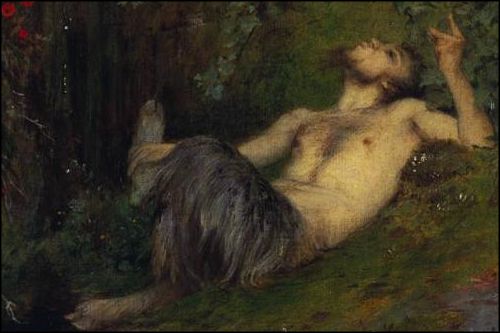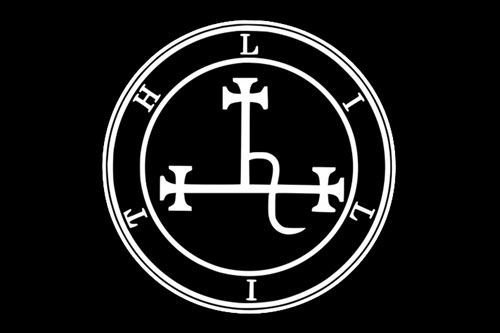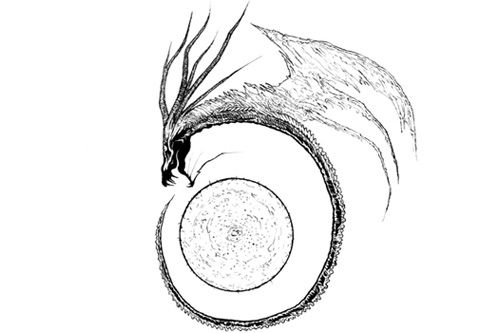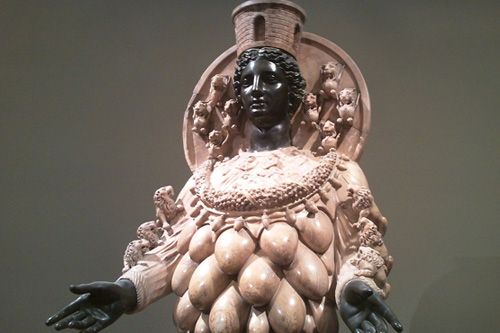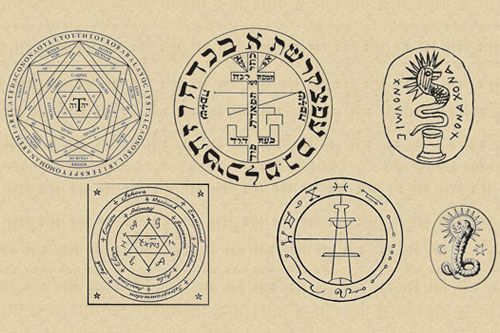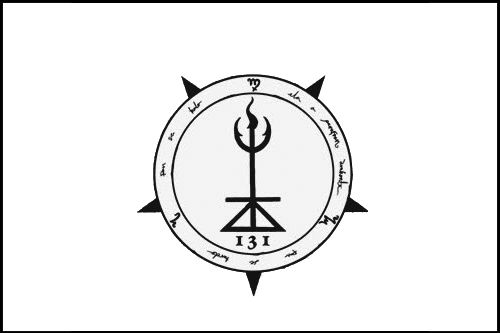Voici la version originale de l’interview de Vexior réalisée par l’éditeur Fall of the Man à l’occasion de la sortie de l’ouvrage Gullveigarbók. Comme elle n’est plus disponible sur le site des éditions, nous la reproduisons ici.
Une traduction de cette interview effectuée par Absentia se trouve par ici : Interview de Vexior / Shamaatae.
*
Vexior has been burning the Veil with the Black Flame of knowledge for over twenty years. His first book, PanParadox, placed him among the most promising new authors in the occult scene, but for those who followed him from before he was already a challenging author, presenting us a different and personal view of Chaos-Gnosticism and the Old Norse religion through several essays, published in Clavicula Nox or his own website. With his second book, Gullveigarbók, he takes us further into the underworld; the home of the giants, and the acosmic Chaos, pointing us into the right direction, for those who dare to learn about the black runes and anti-cosmic magic.
Could you tell us how you started to dabble with the occult? What made you start walking the path of Chaos-Gnosticism?
I found the left hand path in my early teens, and as I grew up listening to Heavy Metal I think it is safe to say that the music influenced me to walk against the headwind and stand out of the crowd. Mythology and religion gave me an enlightenment I had never had before; something very special which made me spiritually dive off the cliffs into the obscurity of the underworld.
In the shadows I found Pan – or Pan found me at a young age – and I just knew that for the first time in my life I was on the right path. With Pan as my guide I experimented with all kinds of different magical praxes; he showed me Chaos and taught me how to connect with it, and he embraced my rebellious and lawless character and led me towards Gnostic ideas.
All this spawned an early nexus with Satanism, and it connected me with a great Anti-Cosmic Satanic Swedish Order which members I came in close friendship with; a brotherhood which introduced me to the foundation of Anti-Cosmic Satanism and Chaos-Gnosticism. I am currently studying religious science at a university, with the ultimate goal of researching Old Norse Religion.
Can you explain to us your approach towards Chaos-Gnosticism and how it can be related to the Old Norse religion?
This is a very big question and not easy to explain in few words. But my personal approach to Chaos-Gnosticism has its foundation in the anti-cosmic way of beholding the cosmos, and what I believe dwells beyond it: Chaos. I like to say that Chaos-Gnosticism is the innards of my belief, apace with anti-cosmic Satanism. The cosmos is ruled and created by a chief demiurgic god who by himself can be called “The Demiurge”; in Old Norse religion he was called Óðinnand in Christian religion he is called God. And in the Gnostic way of beholding things this demiurge was once spawned in Chaos and refused to be one with it; he wanted to rule all, but as that obviously was impossible he broke free from it and created his own world where he could be Creator and Chief-Ruler. And this world is what we know of as the cosmos. But as The Demiurge wanted to be a Tyrant he created barriers so that Chaos and its powers could not enter, and he enslaved everything within the cosmos by creating laws and order. This restriction is what we call space and time dimensions, cosmic laws, etc.; things people are very fascinated with and think of being good but, which are, in a Gnostic point-of-view, the origin of “evil”, as these limited laws and orders keep us from being free as spirits; we are being bound by flesh, celestial and divine powers, etc. This makes The Demiurge, i.e. God, an “Evil Tyrant” who enslaves us to worship him and live by his restricted rules.
And this makes Chaos the origin of all where from the “rebellious” gods derives – gods as Lucifer and Lilith, who by my heavy studies are equivalent to the Old Norse giants Loki and Gullveig. Lucifer and Loki are known to bring light, which is in a Gnostic point-of-view “enlightenment”: true divine knowledge, which in Gnosticism is simply called “gnosis”. And this “gnosis” is of course forbidden by The Demiurge, because it tells the truth and it will destroy him and his creation.
And this “gnosis” in Old Norse mythology is called “the flames of Múspellzheimr”, or “eitr” which means poison. This “eitr”, as explained in the Old Norse sagas, derives from the underworldly icy well called “Hvergelmir”; a well which waters are coming out from Chaos and intruding the cosmos as wrathful and antagonistic powers: it is this transformation – from lawless Chaos to lawlike Cosmos – where the waters/powers are becoming supernatural and deformed, because they are not of the cosmos and they cannot adjust fully to the cosmic restrictions and laws: hence the adjectival umbrella term “anti-cosmic”.
Even though the Old Norse people were very innovative and religious, they did not know of an “acosmic Chaos”, so they tried to explain the divine powers and the cosmogony in the best way they could. And “Ginnungagap” was the closest thing to Chaos they could comprehend. (In Gullveigarbók I will explain the analogies between “gapGinnunga / Ginnungagap” and Chaos.) Niflheimr and Múspellzheimr were Chaos for them, and in Gullveigarbók you will find an in-depth study of this.
How do your studies into the occult affect your daily life? Do you approach it only from the intellectual side, or on the contrary you apply it on a daily basis?
My interest and fascination of the Sinister Left Hand Path and Powers led me in an early age into the practise of black magic, which, by my wolfish hunger, escalated into a deeper praxis and invocation of the Powers of Chaos. And by time the Flames of Múspellzheimr have strengthened and enlightened my spirit, and the Darkness of Niflheimrhas transformed and partly freed my spirit. By my understanding the Black Flames of Chaos have awoken my spiritual awareness, which in its turn have also made me into a religious man. And as I have adopted the Old Norse religion, my religious traditions are very important to me and they shape my daily life in many aspects. I am a devotee and a worshipper of the Thursian Powers, I call it the Thursatru Tradition (Þursatrú Siðr).
My studies are my approach to understanding the ways of our forefathers, and the mythological aspects of the Old religion(s) holds keys to Thursian mysteries yet unsolved. And to satisfy my hungry spiritual flame I embrace everything from books to evocations to unravel the understanding of Chaos. All my writings are collections of my studies, discoveries, understandings, and grimoires of my practical approach.
What’s your opinion about lodges and any other kind of groups? It is generally accepted that there’s a given point in one’s magical development where it’s necessary to work on a group-basis, instead of alone. Do you agree with this affirmation?
If you manage to gather a dedicated group of individuals that actually are working as an entity with the same tradition, then I believe it is a very good thing. But as I’ve experienced myself, that is a very hard task. Temple of the Black Light is the only “magical order” that actually manages this, of all the “magical orders” I’ve come across.
Which authors have influenced you most? And what do you think about the work of other authors, such as Thomas Karlsson, that also explore the dark side of the Old Norse mythology and its traditions?
The Swedish author Viktor Rydberg has truly been my biggest influence as an author; not only because he made a fantastic research on the Old Norse mythology and religion, but for the reason that he was a genuine rebel in his time which spoke through his writings. All his theories were not accurate though, but he dared to bring the sinister powers in the Old religion into the light, which in that time many other respected authors and professors in the subject denied and rather blamed on the Christendom’s intrusion in Scandinavia during the Middle Ages.
Other inspiring researchers/authors connected to the Old Norse studies are Christian Bang, Sophus Bugge, Sigurd Agrell, Otto von Friesen, Emanuel Linderholm, Ivar Lindquist, M. N. Petersen, Dag Strömbäck, Britt-Mari Näsström, Catharina Raudvere, and Stephen Flowers to mention a few. I also think Thomas Karlsson is a good author, I own his books, but the problem I see in many of today’s authors and researchers of the Old Norse mythology and religion, is that they trust too much in the “typical academic approach”.
Your essay “Odinists, Germanic Neopaganists, and Heathenists!” provoked quite a fuzz and all kind of reactions. Why you think people are so reactionary when it comes to accept, or even discuss, different views about the Old Norse religion, or its similarities with other ancient religions? Were you intentionally trying to provoke people, or you never expected it to happen?
Maybe I wanted to provoke, but my primary intention was to plant a seed in the stagnated minds of the “heathenists”. The whole point is that there has only been one way of beholding the Eddas and the Old Norse mythology; the ǽsir-gods have been so much in focus that people seriously say: “Why would anyone want to worship the giants, aren’t they just slow and stupid?” Here is the answer to that: “No, it is you who are slow and stupid; you are too lazy to actual read what the sagas say.”
I believe that people want the Old Norse mythology and religion to be so original and exclusive that they have a very hard time accepting the sagas influences and connections. The Old Norse mythology IS original and has its own character overall, but it doesn’t mean that it had no external influences. The Old Norse people were somewhat of eclectic thinkers and that is obvious when you read the Old sagas. And the millennia of migration from the southern and eastern parts of Europe and the world to the north give a self-explanatory testimony of a cultural trade and influence.
What can people expect from Gullveigarbók? Do you consider it a book for everybody, or you think it may be difficult to understand for those who were never really into the Old Norse religion?
I would say that Gullveigarbók is first off a heavy study on the underworldly side of the Old Norse mythology. I have thoroughly investigated the giants and their traits and powers, and of course my main focus lies on the giantess Gullveig – chief-ruler of the Ironwood. It is more a deep study of the sinister and thursian powers of the Old Norse mythology and religion than a grimoire of Old Norse black magic. Even though, there is a part in the Gullveigarbókwhich I call “Fjølkyngi” which holds “the esoteric aspects and praxis of my own workings of witchcraft in the line of what is called the Thursatru Tradition – Þursatrú siðr – and it divulges a small part of my magical Gullveig-workings.” If people expect a grimoire they have to wait on my other book which I am still working on called URAM – which deals only with Old Norse black magic (you can read more about URAM on my webpage.)
I believe Gullveigarbók is a heavy read, but I’ve tried to write it in a way for anyone to grasp the essence of my understandings. I have for example added references to all my sources so it is easy for anyone to look it up themselves, and so on.
What made you choose Babalon Graphics to illustrate “Gullveigarbók”? Are you satisfied with his work?
It was actually Philippe on Debemur Morti Productions who introduced me to Helgorth’s art, and I knew right away that he was the artist for my visions. And yes I am very satisfied, he has made an amazing job, I am very picky with art as I am artistic myself and Helgorth has done very similar illustrations to my own visions.
You’ve been working for several years on the manuscript, so how does it feel to look back and see where this work has taken you to? Has the process of writing it changed your vision of the world?
It has been a long and enlightening journey for me. I have become so much more in the name of Gullveig and Niflheimr by working with their powers and studying their mythology. I did not realize that she held the keys to so many Old Norse mysteries when I first start to pay attention to her ten years ago; it has truly been a sublime journey, a journey which will never end for me as I will always work with Gullveig and be her true devotee.
You are the first one (as far as I know) that associates Gullveig with Lilith and Loki with Lucifer. How did you come up with that association, and why you think nobody realized it before?
Most of the people that are into the Old Norse mythology are Odinists or Heathenists, and they stare themselves blind in the wrong kind of light; just like their áss-idol Óðinn did at Mímir’s, he stared himself half-blind in poisonous waters of the giants just because his will was only pure tyrannical greed.
Gullveig has been ignored throughout the modern era, only been brought up as a manifestation of Freyja. Nobody has actually studied her mythological traits and her chronicle, and that is simply why nobody really knows anything about her mythology. And if nobody knows who she is, there is no one to worship her as the arch-mother of the Thursian race either. The same goes with Loki, though there are people who have connected him with the sinister powers of the giants, instead of blasphemously called him an áss.
This enlightenment came to me pretty early through my simple rituals to Loki and Hel; I started to get “hunches” of mythological theories which I eagerly started to investigate, and all of a sudden I had open the gates to the underworld and I saw everything very clear. There is no doubt whatsoever in my mind and spirit that Loki’s black flame led me to this sinister and thursian path. And as soon as I started to study the Edda-sagas and understood all epithets and analogies I saw how it was explained pretty clearly about the giants and their chief-rulers. It probably took me three to four years to get an overall understanding of the complex allegorizations of the genealogical chronicle of Gullveigand Loki (and their children.)
